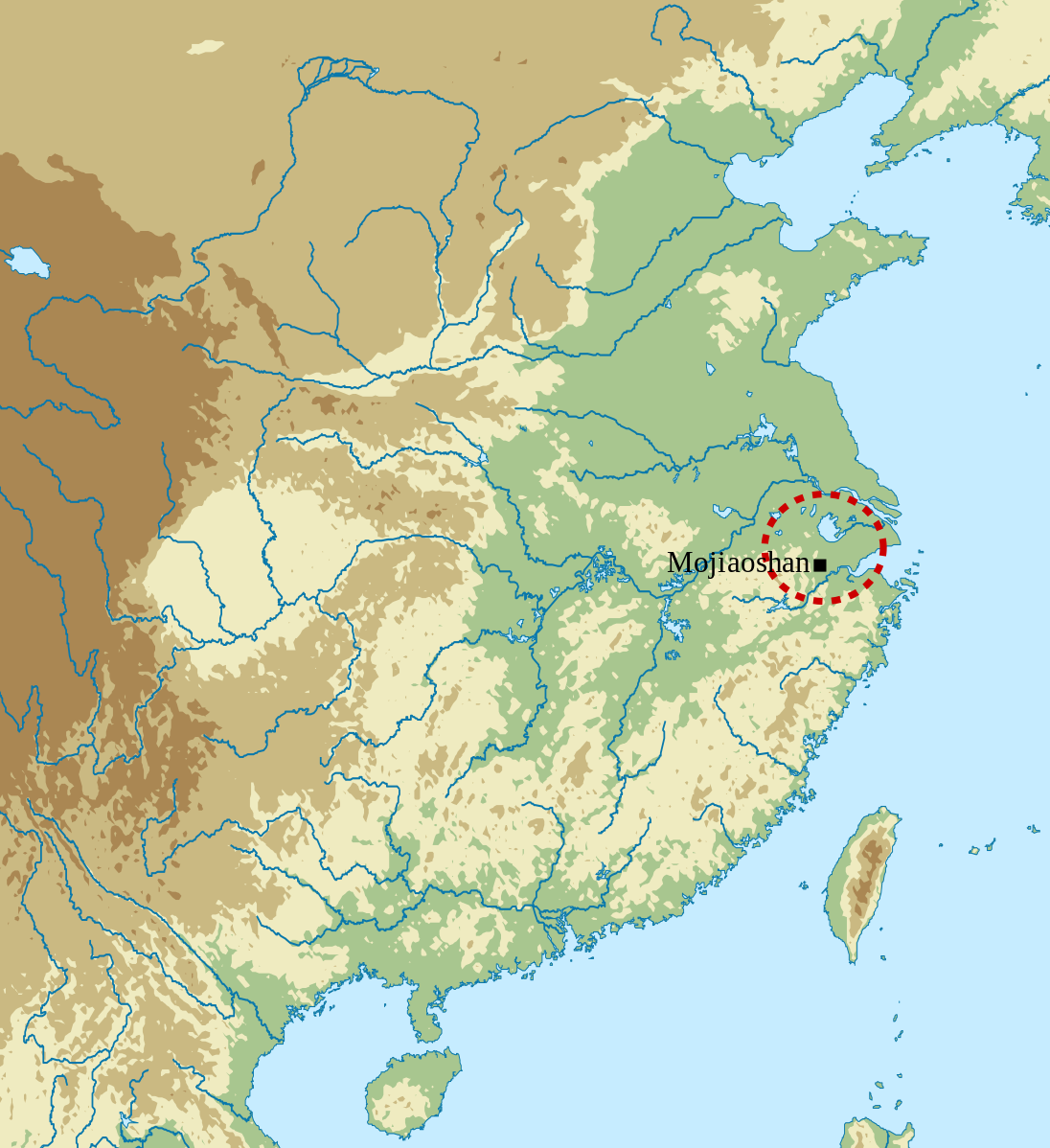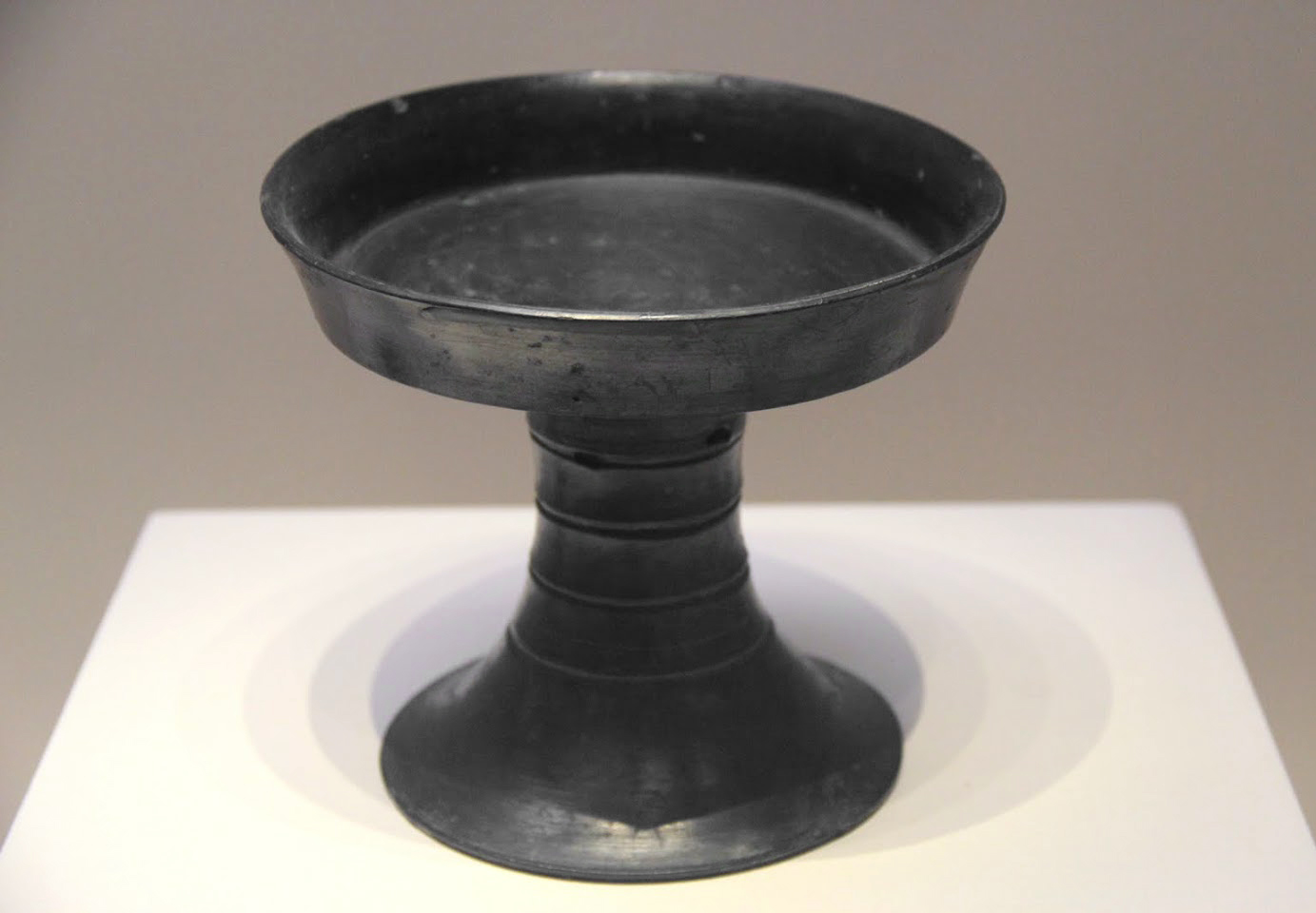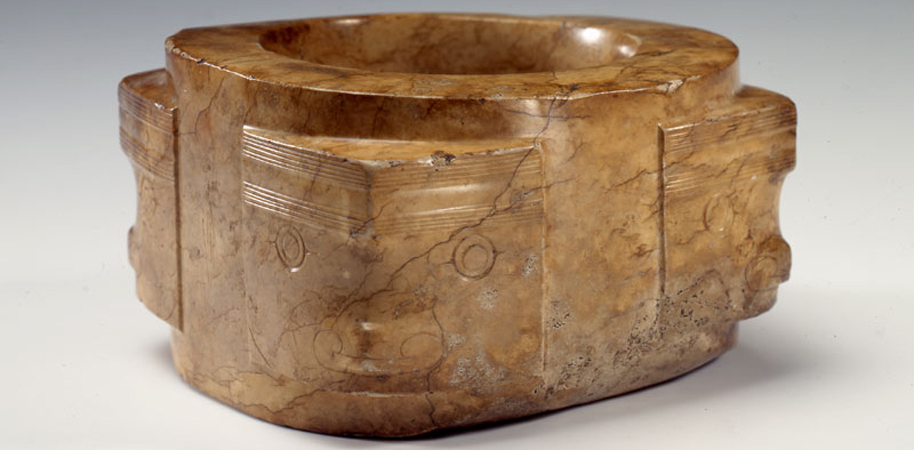2.7: Liangzhu Culture (3300 -2250 BCE)
- Page ID
- 222348
\( \newcommand{\vecs}[1]{\overset { \scriptstyle \rightharpoonup} {\mathbf{#1}} } \)
\( \newcommand{\vecd}[1]{\overset{-\!-\!\rightharpoonup}{\vphantom{a}\smash {#1}}} \)
\( \newcommand{\id}{\mathrm{id}}\) \( \newcommand{\Span}{\mathrm{span}}\)
( \newcommand{\kernel}{\mathrm{null}\,}\) \( \newcommand{\range}{\mathrm{range}\,}\)
\( \newcommand{\RealPart}{\mathrm{Re}}\) \( \newcommand{\ImaginaryPart}{\mathrm{Im}}\)
\( \newcommand{\Argument}{\mathrm{Arg}}\) \( \newcommand{\norm}[1]{\| #1 \|}\)
\( \newcommand{\inner}[2]{\langle #1, #2 \rangle}\)
\( \newcommand{\Span}{\mathrm{span}}\)
\( \newcommand{\id}{\mathrm{id}}\)
\( \newcommand{\Span}{\mathrm{span}}\)
\( \newcommand{\kernel}{\mathrm{null}\,}\)
\( \newcommand{\range}{\mathrm{range}\,}\)
\( \newcommand{\RealPart}{\mathrm{Re}}\)
\( \newcommand{\ImaginaryPart}{\mathrm{Im}}\)
\( \newcommand{\Argument}{\mathrm{Arg}}\)
\( \newcommand{\norm}[1]{\| #1 \|}\)
\( \newcommand{\inner}[2]{\langle #1, #2 \rangle}\)
\( \newcommand{\Span}{\mathrm{span}}\) \( \newcommand{\AA}{\unicode[.8,0]{x212B}}\)
\( \newcommand{\vectorA}[1]{\vec{#1}} % arrow\)
\( \newcommand{\vectorAt}[1]{\vec{\text{#1}}} % arrow\)
\( \newcommand{\vectorB}[1]{\overset { \scriptstyle \rightharpoonup} {\mathbf{#1}} } \)
\( \newcommand{\vectorC}[1]{\textbf{#1}} \)
\( \newcommand{\vectorD}[1]{\overrightarrow{#1}} \)
\( \newcommand{\vectorDt}[1]{\overrightarrow{\text{#1}}} \)
\( \newcommand{\vectE}[1]{\overset{-\!-\!\rightharpoonup}{\vphantom{a}\smash{\mathbf {#1}}}} \)
\( \newcommand{\vecs}[1]{\overset { \scriptstyle \rightharpoonup} {\mathbf{#1}} } \)
\( \newcommand{\vecd}[1]{\overset{-\!-\!\rightharpoonup}{\vphantom{a}\smash {#1}}} \)
\(\newcommand{\avec}{\mathbf a}\) \(\newcommand{\bvec}{\mathbf b}\) \(\newcommand{\cvec}{\mathbf c}\) \(\newcommand{\dvec}{\mathbf d}\) \(\newcommand{\dtil}{\widetilde{\mathbf d}}\) \(\newcommand{\evec}{\mathbf e}\) \(\newcommand{\fvec}{\mathbf f}\) \(\newcommand{\nvec}{\mathbf n}\) \(\newcommand{\pvec}{\mathbf p}\) \(\newcommand{\qvec}{\mathbf q}\) \(\newcommand{\svec}{\mathbf s}\) \(\newcommand{\tvec}{\mathbf t}\) \(\newcommand{\uvec}{\mathbf u}\) \(\newcommand{\vvec}{\mathbf v}\) \(\newcommand{\wvec}{\mathbf w}\) \(\newcommand{\xvec}{\mathbf x}\) \(\newcommand{\yvec}{\mathbf y}\) \(\newcommand{\zvec}{\mathbf z}\) \(\newcommand{\rvec}{\mathbf r}\) \(\newcommand{\mvec}{\mathbf m}\) \(\newcommand{\zerovec}{\mathbf 0}\) \(\newcommand{\onevec}{\mathbf 1}\) \(\newcommand{\real}{\mathbb R}\) \(\newcommand{\twovec}[2]{\left[\begin{array}{r}#1 \\ #2 \end{array}\right]}\) \(\newcommand{\ctwovec}[2]{\left[\begin{array}{c}#1 \\ #2 \end{array}\right]}\) \(\newcommand{\threevec}[3]{\left[\begin{array}{r}#1 \\ #2 \\ #3 \end{array}\right]}\) \(\newcommand{\cthreevec}[3]{\left[\begin{array}{c}#1 \\ #2 \\ #3 \end{array}\right]}\) \(\newcommand{\fourvec}[4]{\left[\begin{array}{r}#1 \\ #2 \\ #3 \\ #4 \end{array}\right]}\) \(\newcommand{\cfourvec}[4]{\left[\begin{array}{c}#1 \\ #2 \\ #3 \\ #4 \end{array}\right]}\) \(\newcommand{\fivevec}[5]{\left[\begin{array}{r}#1 \\ #2 \\ #3 \\ #4 \\ #5 \\ \end{array}\right]}\) \(\newcommand{\cfivevec}[5]{\left[\begin{array}{c}#1 \\ #2 \\ #3 \\ #4 \\ #5 \\ \end{array}\right]}\) \(\newcommand{\mattwo}[4]{\left[\begin{array}{rr}#1 \amp #2 \\ #3 \amp #4 \\ \end{array}\right]}\) \(\newcommand{\laspan}[1]{\text{Span}\{#1\}}\) \(\newcommand{\bcal}{\cal B}\) \(\newcommand{\ccal}{\cal C}\) \(\newcommand{\scal}{\cal S}\) \(\newcommand{\wcal}{\cal W}\) \(\newcommand{\ecal}{\cal E}\) \(\newcommand{\coords}[2]{\left\{#1\right\}_{#2}}\) \(\newcommand{\gray}[1]{\color{gray}{#1}}\) \(\newcommand{\lgray}[1]{\color{lightgray}{#1}}\) \(\newcommand{\rank}{\operatorname{rank}}\) \(\newcommand{\row}{\text{Row}}\) \(\newcommand{\col}{\text{Col}}\) \(\renewcommand{\row}{\text{Row}}\) \(\newcommand{\nul}{\text{Nul}}\) \(\newcommand{\var}{\text{Var}}\) \(\newcommand{\corr}{\text{corr}}\) \(\newcommand{\len}[1]{\left|#1\right|}\) \(\newcommand{\bbar}{\overline{\bvec}}\) \(\newcommand{\bhat}{\widehat{\bvec}}\) \(\newcommand{\bperp}{\bvec^\perp}\) \(\newcommand{\xhat}{\widehat{\xvec}}\) \(\newcommand{\vhat}{\widehat{\vvec}}\) \(\newcommand{\uhat}{\widehat{\uvec}}\) \(\newcommand{\what}{\widehat{\wvec}}\) \(\newcommand{\Sighat}{\widehat{\Sigma}}\) \(\newcommand{\lt}{<}\) \(\newcommand{\gt}{>}\) \(\newcommand{\amp}{&}\) \(\definecolor{fillinmathshade}{gray}{0.9}\)Introduction
The Liangzhu culture, located near coastal China (2.7.1), was one of the last major Neolithic cultures although very influential in the region. The culture was based on jade, silk, and ivory, materials found in elite burials, and common people were buried with pottery, indicating the development of an elite population. The culture was especially powerful around 2500 BCE and then disappeared about two hundred years later. Historians believe the culture may have been extinguished because of flooding from the Yangtze River. The culture was very advanced in agriculture practices with extensive irrigation, rice cultivation, and integrated aquaculture. The Liangzhu villages were close to rivers, and evidence of boats, oars and houses built on stilts have been found. The archaeological ruins of Liangzhu illustrate the evolution from small-scale societies of the Neolithic period to larger urbanization. Researchers found evidence of city planning, social hierarchy, levels of power struggles, and sophisticated organization of space.

China's ancient Liangzhu Archaeological Site was declared a World Heritage site by UNESCO's World Heritage Committee in July 2019. The site, located in Yuhang District of Hangzhou City, east China's Zhejiang Province, showcases that civilization had existed in China between 3300 B.C. and 2300 B.C. Now, the Liangzhu Archaeological Site has been rebuilt as a tourist attraction, preserving the ruins as much as possible. People once described the site as "the 5,000-year civilization demonstrated by jade" because thousands of jade artifacts were unearthed from Fanshan Cemetery at the site. There are 11 tombs discovered in the cemetery.
Additional text/introduction.
Architecture
Liangzhu only had one road through the city walls, and most of the transportation was carried on boats moving on a network of canals. Canals were formed as part of the series of dams creating vast reservoirs. A major part of the city was an immense complex constructed high on an earthen platform. Huge granaries dominated the skyline, with residential houses spread through smaller grouped areas. The city was surrounded by rammed earth clay walls (2.7.2) with six gates leading into the city, protecting entrance by water or a road. Excavated remains also revealed workshops, docks, altars, and the extensive layout for residences. Housing close to the water was erected on stilts as protection against flooding, while houses on higher ground might have subterranean areas below the house. Thatching was used for roofs. Elaborate tombs dotted the landscape, indicating some social classes seen in the tombs. Large numbers of highly designed jade objects were the major decorative element on the tombs, indicating a whole industry based on jade production.
Art
This stunning goblet (2.7.3) features three distinct parts - a cup with a flared rim, a petite stem, and a sturdy base - all with a sleek and polished finish. Similarly, the black jug (2.7.4) bears ornate rings for decorative purposes, much like the bowl. The Liangzhu people were highly skilled in pottery-making, able to create pottery in any shape using a spinning wheel. The Liangzhu pottery shared some similarities with Longshan black pottery, but its soft-fired gray color and black slip coating gave it a unique appearance achieved by altering clay particles during the firing process. Air introduced into the kiln during the final cooling stage caused oxidation of the outer parts of the pottery, resulting in a heavily smoked appearance.


The Liangzhu defined jade as a high-value element. Although no written records have been found, large quantities of jade in different places and shapes demonstrated the use of jade for important activities. Jade was carved into disks (bi) or tubes (cong) and incised with multiple styles of markings. Their use of jade influenced future generations. Most of the objects were located in tombs lined around the deceased person. The use of the bi or cong is unknown; however, the objects were luxuries because of the skilled labor or cost of materials to make the objects.
Historians believe there was an existence of a ruling or elite class demonstrating social organization or a type of religious belief. Several ancient Chinese societies used jade described as “the fairest of stones.” The cong (2.7.5) and bi (2.7.6) are examples of the jade objects found in Liangzhu burial sites. The cong are usually incised with small mask-like faces. On this cong, the faces are found on the corners of the cong and have two eyes and a curved shape similar to a mouth. Two rows of lines are incised across the top. The bi is carved into a perfectly round circle with an exact hole in the center. Jade is exceptionally hard and cannot be carved. Artists would have to use drills of some type and abrasive material like sand. The production and distribution of prestigious items may potentially give greater control to an elite group economically and symbolically. Some historians theorize an elite ruling class existed and reflected their power using jade for personal power.[1]


Jade Cong, c. 2500 B.C.E., Liangzhu culture, Neolithic period, China (British Museum)
Additional text/introduction.
[1] LIU, L. (2003). “The Products of Minds as Well as of Hands”: Production of Prestige Goods in the Neolithic and Early State Periods of China. Asian Perspectives, 42(1), 1–40. http://www.jstor.org/stable/42929204


